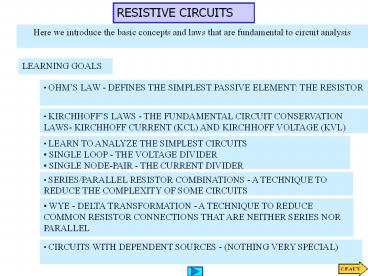RESISTIVE CIRCUITS - PowerPoint PPT Presentation
Title:
RESISTIVE CIRCUITS
Description:
RESISTIVE CIRCUITS Here we introduce the basic concepts and laws that are fundamental to circuit analysis LEARNING GOALS OHM S LAW - DEFINES THE SIMPLEST PASSIVE ... – PowerPoint PPT presentation
Number of Views:132
Avg rating:3.0/5.0
Title: RESISTIVE CIRCUITS
1
RESISTIVE CIRCUITS
Here we introduce the basic concepts and laws
that are fundamental to circuit analysis
LEARNING GOALS
- OHMS LAW - DEFINES THE SIMPLEST PASSIVE
ELEMENT THE RESISTOR
- KIRCHHOFFS LAWS - THE FUNDAMENTAL CIRCUIT
CONSERVATION LAWS- KIRCHHOFF CURRENT (KCL) AND
KIRCHHOFF VOLTAGE (KVL)
- LEARN TO ANALYZE THE SIMPLEST CIRCUITS
- SINGLE LOOP - THE VOLTAGE DIVIDER
- SINGLE NODE-PAIR - THE CURRENT DIVIDER
- SERIES/PARALLEL RESISTOR COMBINATIONS - A
TECHNIQUE TO REDUCE THE COMPLEXITY OF SOME
CIRCUITS
- WYE - DELTA TRANSFORMATION - A TECHNIQUE TO
REDUCE COMMON RESISTOR CONNECTIONS THAT ARE
NEITHER SERIES NOR PARALLEL
- CIRCUITS WITH DEPENDENT SOURCES - (NOTHING VERY
SPECIAL)
2
RESISTORS
A resistor is a passive element characterized by
an algebraic relation between the voltage
across its terminals and the current through it
Conductance
If instead of expressing voltage as a function of
current one expresses current in terms of
voltage, OHMs law can be written
A linear resistor obeys OHMs Law
The constant, R, is called the resistance of the
component and is measured in units of Ohm
From a dimensional point of view Ohms is a
derived unit of Volt/Amp
Since the equation is algebraic the time
dependence can be omitted
3
Some practical resistors
Symbol
4
Notice passive sign convention
Two special resistor values
5
OHMS LAW PROBLEM SOLVING TIP
One equation and three variables. Given ANY two
the third can be found
Determine direction of the current using passive
sign convention
Notice use of passive sign convention
6
GIVEN VOLTAGE AND CONDUCTANCE
OHMS LAW
UNITS?
REFERENCE DIRECTIONS SATISFY PASSIVE SIGN
CONVENTION
UNITS?
CONDUCTANCE IN SIEMENS, VOLTAGE IN VOLTS. HENCE
CURRENT IN AMPERES
7
A MATTER OF UNITS
RESISTORS AND ELECTRIC POWER
Working with SI units Volt, Ampere Watt, Ohm,
there is never a problem. One must be careful
when using multiples or sub multiples.
Resistors are passive components that can only
absorb energy. Combining Ohms law and the
expressions for power we can derive several
useful expressions
The basic strategy is to express all given
variables in SI units
Problem solving tip There are four variables
(P,v,i,R) and two equations. Given any two
variables one can find the other two.
If not given, the reference direction for
voltage or current can be chosen and the other
is given by the passive sign convention
8
(No Transcript)
9
R V/I 2.4 Ohms
I P/V 5A
Q560C
SAMPLE PROBLEM
Possibly useful relationships
Recognizing the type of problem This is an
application of Ohms Law We are given Power and
Voltage. We are asked for Resistance, Current and
Charge
10
Given charge. Required current
Given current. Required voltage
Given current, resistor, voltage. Required power
On the time interval, current from a to b is
negative.
Current flows from b to a and point b has the
higher voltage
SAMPLE QUESTION































